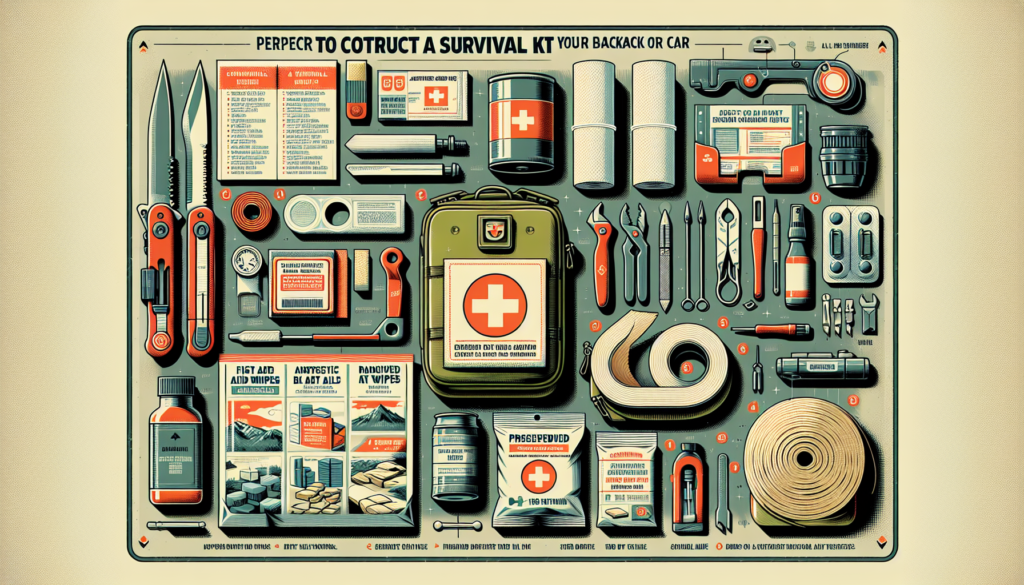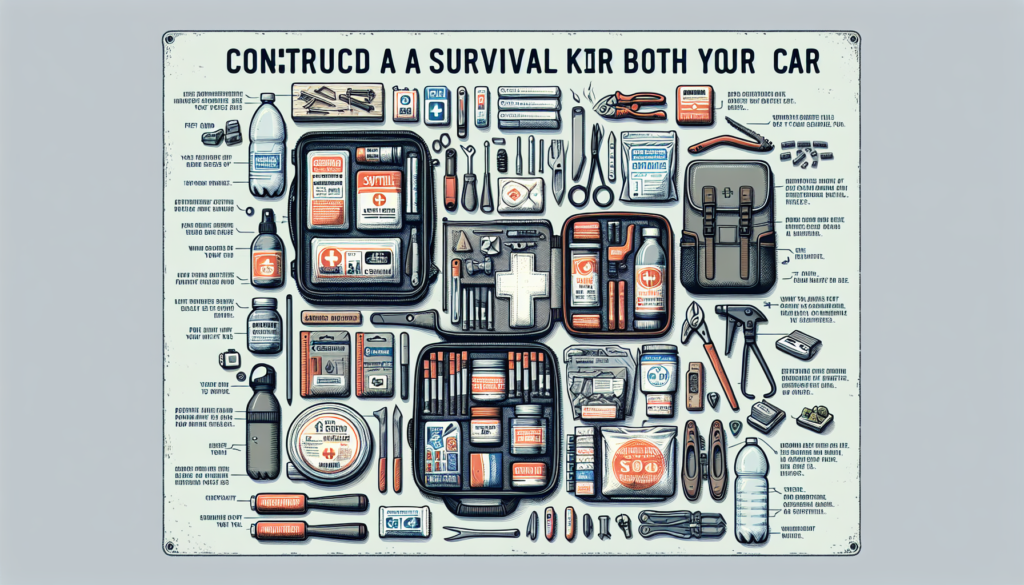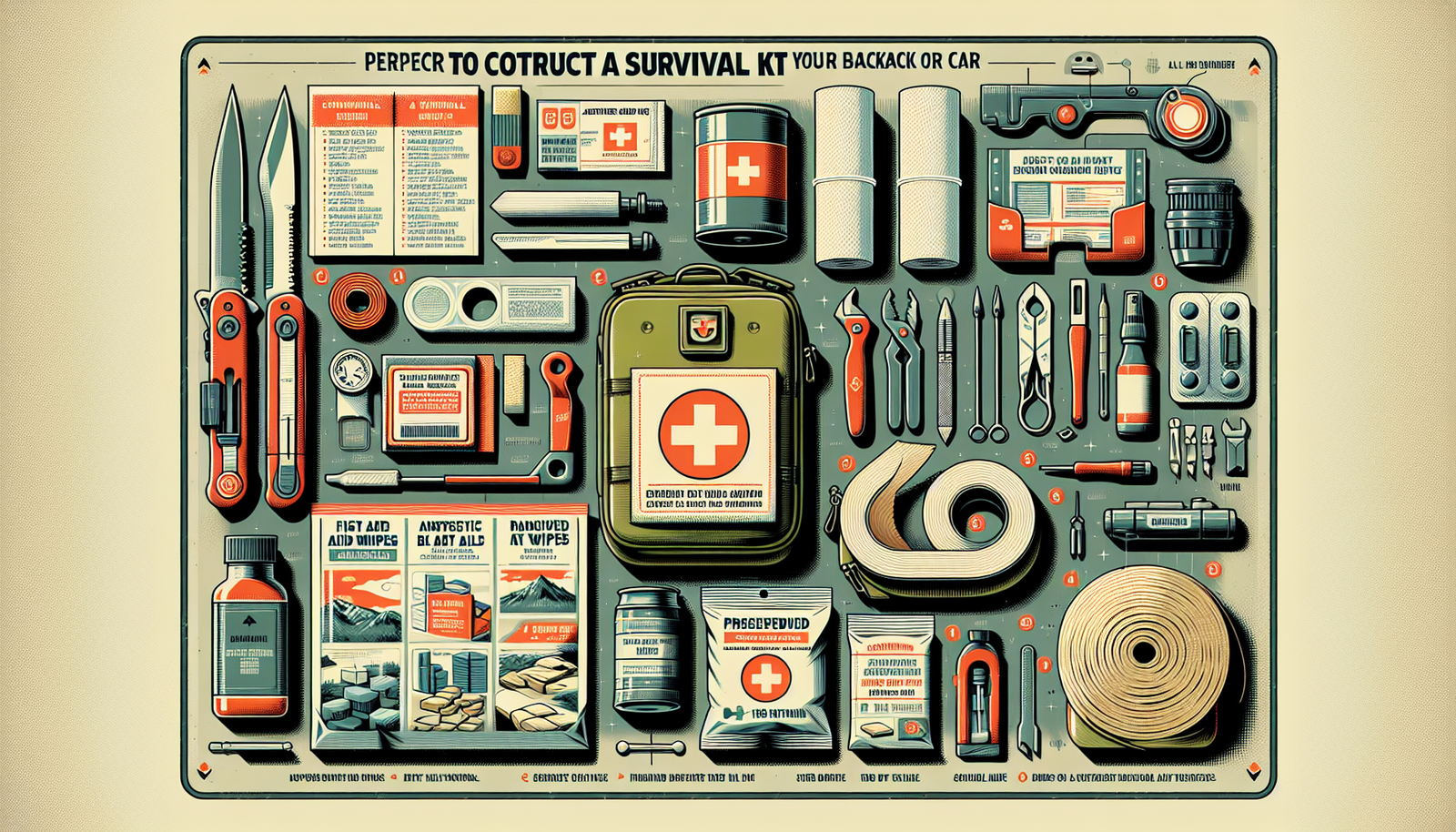In a world full of uncertainties, it’s essential to be prepared for unexpected situations. Building a survival kit for your backpack or car can give you peace of mind and potentially save lives. Whether you’re an outdoor enthusiast or simply want to be ready for life’s unpredictable twists, this article provides you with practical tips and knowledge to cope with emergencies. From building shelters to finding water and food, staying warm, and signaling for help, these essential survival skills empower you to become self-reliant and resilient in the face of adversity. So, let’s dive into the world of survival kits and learn how to equip ourselves for any challenging situation that may come our way.
Choosing the Right Container
When building a survival kit, one of the first considerations is choosing the right container to hold all your essential items. The container should be durable and able to withstand harsh conditions. Look for a container that is waterproof and sealable to protect your supplies from moisture and other environmental factors that could damage them. Additionally, consider the size of the container; it should be large enough to hold all your items comfortably, but not so large that it becomes inconvenient to carry. By selecting the right container, you can ensure that your survival kit remains intact and your supplies stay safe and secure.
Size and Durability
The size of your survival kit container is an important factor to consider. It should be large enough to hold all the necessary items, including food, water, shelter, and tools, without being too bulky or cumbersome to carry. A compact container that fits easily into your backpack or car is ideal, as it allows for easy transportation.
Durability is also crucial when choosing a container. You want something that can withstand rough handling and exposure to the elements. Look for a container made from strong materials, such as sturdy plastic or metal, that can resist impact and protect your supplies from damage.
Waterproof and Sealable
Another key feature to look for in a survival kit container is waterproofing. Ensure that the container you choose is waterproof or at least water-resistant. This will help protect your supplies from moisture, rain, or accidental submersion in water. A waterproof container is especially important if you’re planning outdoor adventures or live in a region prone to heavy rainfall.
In addition to being waterproof, a sealable container is essential to keep your supplies secure and protected. Look for a container that has a reliable sealing mechanism, such as a tight-fitting lid or airtight seal. This will prevent water, dust, or pests from entering the container and damaging your essential items. With a waterproof and sealable container, you can have peace of mind knowing that your survival kit is well-protected no matter the circumstances.
Shelter and Warmth
In emergency situations, having adequate shelter and warmth is crucial for survival. Your survival kit should include items that can help you stay protected from the elements and maintain a comfortable body temperature. Here are some essential items to consider including in your kit:
Emergency Blanket
An emergency blanket, also known as a space blanket or thermal blanket, is a lightweight and compact item that provides insulation and reflects body heat back to the user. It is made from a thin, metallic material that helps retain warmth and shields against wind and moisture. Emergency blankets are an excellent addition to any survival kit as they can be used for both shelter and warmth.
Tarp or Tent
A tarp or tent is essential for creating a more substantial and reliable shelter. A tarp is versatile and can be used in various ways, such as creating a makeshift tent, providing protection from rain or wind, or serving as a ground cover. A lightweight and compact tent is also a good option for longer-term survival situations or when camping outdoors. Choose a tarp or tent that is durable, easy to set up, and provides adequate protection from the elements.
Sleeping Bag
A sleeping bag is crucial for maintaining body heat and providing a comfortable sleeping surface. Look for a sleeping bag that is lightweight, compact, and suitable for the climate in which you will be using it. Consider the temperature rating of the sleeping bag to ensure it can keep you warm in colder conditions. Additionally, choose a sleeping bag that is easy to pack and carry, as it will be an essential item in your survival kit.
Extra Clothing
Including extra clothing, such as warm layers and waterproof outerwear, in your survival kit is essential. Choose clothing made from materials that insulate well, dry quickly, and provide protection against wind and rain. Pack items like thermal underwear, a fleece jacket, a waterproof outer shell, and extra socks. These extra layers will help you stay warm and dry, even in challenging weather conditions.
Fire-starting Tools
Fire is not only a source of warmth, but it also provides the ability to cook food, purify water, and signal for help. Having reliable fire-starting tools in your survival kit is essential. Here are some tools to consider including:
Waterproof Matches
Waterproof matches are an excellent addition to any survival kit. They are specially designed to stay dry and ignite even in wet conditions. With waterproof matches, you can ensure that you’ll be able to start a fire no matter the weather or environmental conditions.
Lighter
A reliable lighter is another essential fire-starting tool. Look for a lighter that is windproof and refillable. Windproof lighters are designed to resist wind and provide a consistent flame, making them ideal for outdoor survival situations. Additionally, opting for a refillable lighter ensures that you won’t run out of fuel when you need it most.
Firestarter
Including a firestarter in your survival kit is a wise decision. Firestarters, such as fire tinder or firestarter sticks, are incredibly efficient at igniting and can be used even in damp conditions. They are compact and lightweight, making them easy to carry in your survival kit. Firestarters provide a reliable backup option in case your matches or lighter fail to ignite a fire.
Tools and Multi-purpose Items
Having the right tools in your survival kit can make all the difference in an emergency situation. Tools not only assist with essential tasks but can also serve multiple purposes. Here are some essential tools and multi-purpose items to consider including:

Knife
A knife is undoubtedly one of the most versatile tools you can have in your survival kit. It can be used for cutting, chopping, carving, opening cans, building shelters, and countless other tasks. Look for a well-made knife with a fixed blade for durability and reliability. Ideally, choose a knife that is lightweight and easily portable, making it convenient to carry at all times.
Multi-tool
A multi-tool is a compact and versatile tool that combines various functions into one device. It usually includes features such as pliers, screwdrivers, knives, saws, and can openers, among others. Having a multi-tool in your survival kit ensures that you have a wide range of tools readily available. Look for a durable and high-quality multi-tool that can withstand heavy use.
Duct Tape
Duct tape is a multi-purpose item that should not be underestimated. It can be used for repairing gear, creating makeshift shelters, securing bandages, or even fashioning a rope in an emergency. Consider packing a small roll of duct tape in your survival kit. Its adhesive properties and versatility make it a valuable asset in a variety of situations.
Navigation and Signaling
In survival situations, knowing your location and being able to signal for help are vital. Including navigation and signaling tools in your survival kit will greatly assist in these situations. Here are some essential items to consider:
Compass
A compass is a must-have item for any survival kit. It allows you to determine your direction and navigate through unfamiliar terrain. Choose a compass that is durable and has clear markings for easy reading. Familiarize yourself with how to use a compass before venturing into the wilderness, as it will be an invaluable tool in finding your way back to safety.
Map
A detailed map of the area you will be exploring or traveling through is essential for navigation. Ensure that the map is up-to-date and includes relevant information such as topography, trails, and landmarks. Familiarize yourself with the map and plan your route before setting out. In an emergency, a map combined with a compass will help you find your way or communicate your location to rescuers.
Whistle
A whistle is a small but powerful signaling device that can attract attention from a considerable distance. It is much louder and more efficient than shouting for help. Opt for a whistle that is lightweight, durable, and loud. The sound of a whistle carries farther than the human voice, making it an essential item for signaling in survival situations.
Signal Mirror
A signal mirror is a highly effective tool for attracting attention during a rescue operation. It reflects sunlight in a concentrated beam, which can be seen at a great distance. Look for a mirror made from durable and scratch-resistant material. Familiarize yourself with how to use a signal mirror properly by practicing aiming the reflected light at a specific target.
Food and Water
In emergency situations, access to food and water is essential for survival. Your survival kit should include provisions to sustain you until help arrives or until you can find additional resources. Here are some items to consider:
Water Bottles or Hydration Bladder
Having a reliable water container is crucial. Choose water bottles or a hydration bladder that are durable, leak-proof, and easy to carry or attach to your backpack. Make sure they have a sufficient capacity to hold an adequate amount of water for your needs. Staying hydrated is vital in survival situations, so ensure that you have the means to carry and store water securely.
Water Purification Tablets
In case you run out of clean drinking water, water purification tablets are an essential backup. They can effectively remove bacteria, viruses, and parasites from contaminated water sources, making it safe to drink. Pack a sufficient number of water purification tablets in your survival kit to ensure that you can purify water when necessary.

Energy Bars or Non-perishable Snacks
Including non-perishable food items such as energy bars, granola bars, or trail mix in your survival kit provides a quick source of energy and nutrients. Choose items that have a long shelf life and are compact and lightweight. These snacks can keep hunger at bay and boost your energy levels until you can find more substantial sources of food.
First Aid Kit
A comprehensive first aid kit is a critical component of any survival kit. In emergency situations, having the necessary medical supplies to treat injuries and illnesses can be lifesaving. Here are some essential items to include in your first aid kit:
Bandages
Assortment of bandages, including adhesive bandages, sterile gauze, and adhesive tape, to treat wounds and control bleeding.
Antiseptic Wipes
Antiseptic wipes or solutions to clean wounds and prevent infection.
Painkillers
Over-the-counter painkillers to relieve minor aches and pains.
Medical Tape
Medical tape to secure bandages or dressings in place.
Emergency Communication
Having a means of communication in emergency situations is crucial. Including communication devices in your survival kit will allow you to call for help or stay in contact with others. Here are some options to consider:
Cell Phone with Backup Battery or Solar Charger
A cell phone is a valuable tool for emergency communication. Ensure that you have a fully charged cell phone before venturing into the wilderness or traveling to remote areas. Additionally, pack a backup battery or a solar charger to keep your phone powered in case of an extended emergency.
Two-Way Radio
In situations where cell phone reception is limited or unavailable, a two-way radio can be a reliable means of communication. Make sure to choose a two-way radio with a long-range and sturdy construction. Familiarize yourself with how to operate the radio and establish communication protocols with your group or rescuers.
Personal Hygiene
Maintaining personal hygiene is often overlooked in survival situations, but it is essential for overall health and well-being. Including personal hygiene items in your survival kit will help you stay clean and prevent the spread of bacteria and disease. Here are some items to consider:
Toilet Paper
Toilet paper is a fundamental personal hygiene item that should not be forgotten. It provides comfort and cleanliness when nature calls.
Hand Sanitizer
Hand sanitizer is a convenient and efficient way to keep your hands clean when soap and water are not readily available. Choose a hand sanitizer with a high alcohol content for maximum effectiveness.
Soap
Pack a small bar of soap or travel-sized liquid soap to maintain cleanliness. Use it to wash your hands, body, and potentially even clothing if necessary.
Safety and Protection
In emergency situations, ensuring your safety and protecting yourself from potential threats is paramount. Including safety and protection items in your survival kit will help you stay secure. Here are some items to consider:
Flashlight
A reliable flashlight is essential for illuminating your surroundings at night or in low light conditions. Choose a flashlight that is lightweight, compact, and has a long battery life. Consider packing extra batteries or an alternative power source, such as a solar-powered charger.
Emergency Whistle
An emergency whistle can attract attention and help others locate you in an emergency. It is a simple but effective tool for signaling for help. Choose a whistle that is loud and durable.
Pepper Spray
Pepper spray can provide a means of self-defense in threatening situations. It is a non-lethal option that can temporarily disable an attacker, giving you time to escape. Ensure that you are familiar with local laws and regulations regarding the use of pepper spray before including it in your survival kit.
In conclusion, building a comprehensive survival kit is essential for being prepared in emergency situations. By considering the size and durability of the container, ensuring waterproofing and sealability, including essential items for shelter, warmth, fire-starting, navigation, food and water, first aid, communication, personal hygiene, and safety, you can create a well-rounded kit that equips you for a wide range of scenarios. Remember to regularly check and update the contents of your survival kit, and familiarize yourself with how to use each item before an emergency arises. By preparing yourself with a robust survival kit, you can face unexpected situations with confidence and resilience, knowing that you have the necessary tools and supplies to overcome challenges and emerge stronger.

